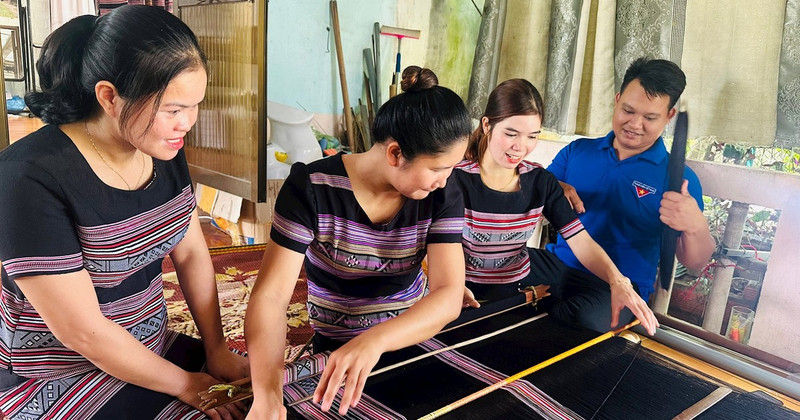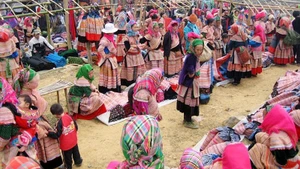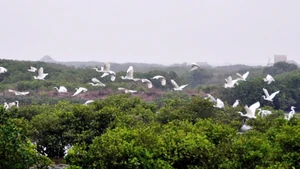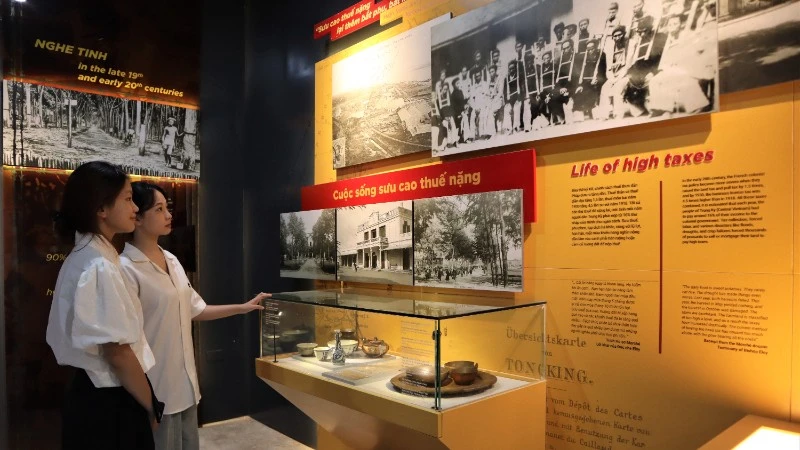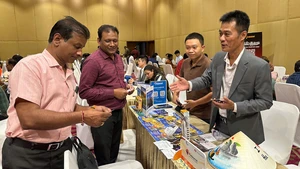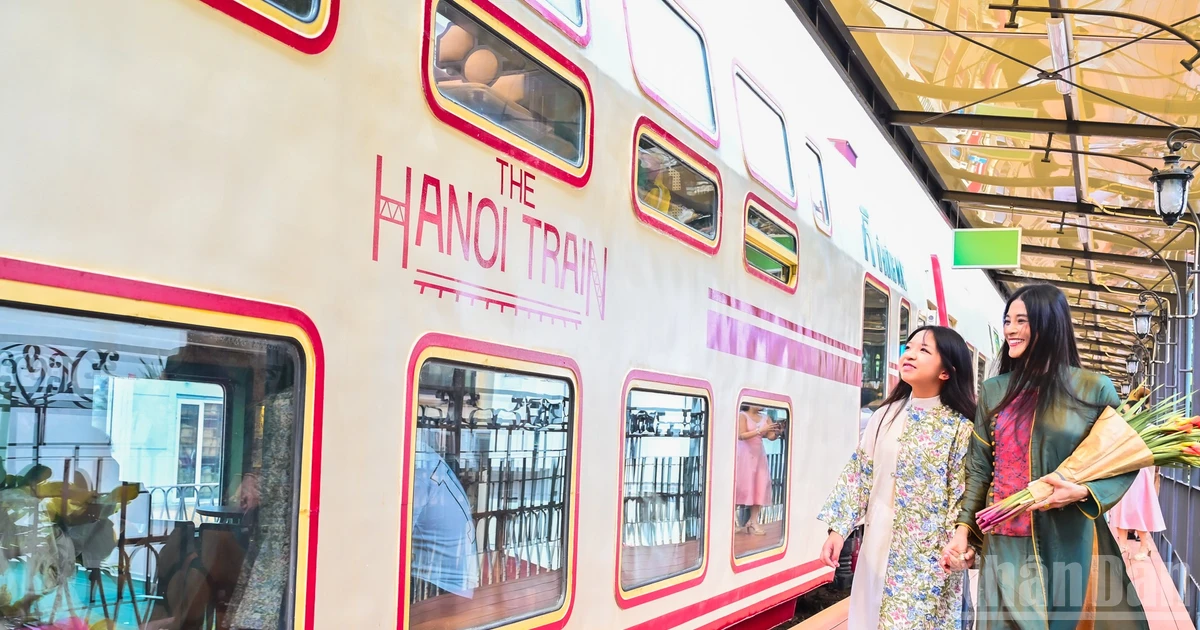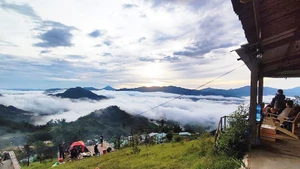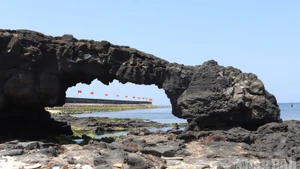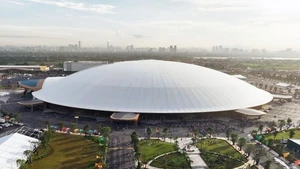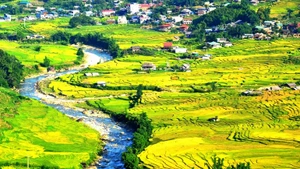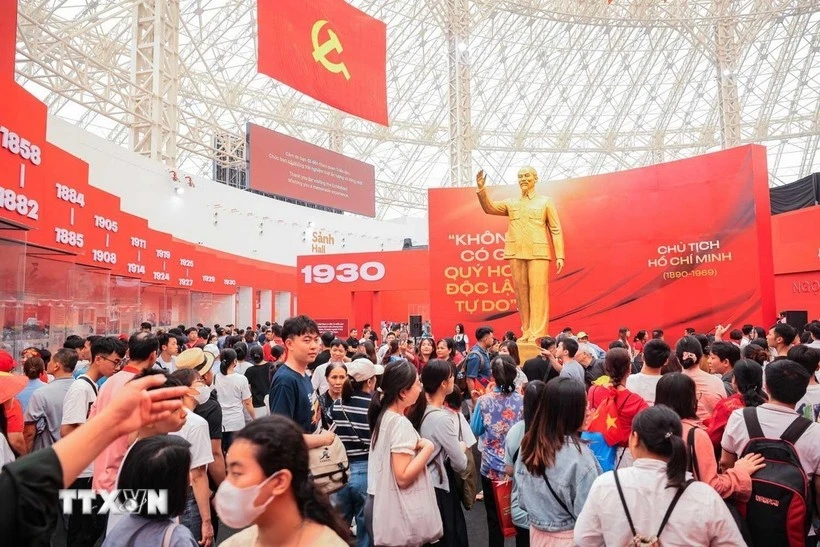The Lien, Re, and Vuc Liem rivers flow like streams of memory, carrying countless sediments of arduous yet heroic years endured by the ethnic minorities in the highlands of Ba To District in Quang Ngai Province. The majestic Cao Muon Mountain stands tall, where the revolutionary flame was kindled 80 years ago.
Time has etched countless resistance stories into forests, peaks, and villages. Gazing up at the imposing Ba To Uprising Monument in the centre of the Ba To Safe Zone, visitors are reminded of those glorious years.
"Sacrifice for the Fatherland," the oath sworn by the legendary Ba To Guerrilla Unit on Cao Muon Mountain still echoes through the vast wilderness. Truong An, Suoi Loa, Nuoc La, and other historical sites continue to shine through the years. The bond between soldiers and civilians and the resistance oath made under the forest canopy at Nuoc Sung blend with the love for homeland and villages held by the ethnic people in Ba To.
Memories from the cradle of revolution
What is today a vibrant countryside was, eighty years ago, a fierce battleground. The Cao Muon Mountain military zone, Lien River bend, Nuoc Nang brick kiln, Suoi Loa watchtower, and Ba To garrison are historical remnants of the Ba To Uprising, once marked by the footsteps of guerrilla forces during times of fire and bullets. Following the revolution, the Hre people's insurgent spirit shone brightly among the mountains and forests in their quest for independence and freedom.
The old battleground remains etched in the annals of the nation’s heroic struggle. On March 11, 1945, while morning dew still clung to the mountain slopes, drums and wooden clappers resonated throughout the Truong An valley, shaking the entire forest region.
At the Suoi Loa watchtower, plans for an armed uprising fuelled by the indomitable spirit of Ba To's highland troops and people were set in motion. By that evening, revolutionary forces together with the masses advanced to capture the Ba To garrison, liberating the district. The Ba To Uprising triumphed, a revolutionary governance was established, and the Ba To National Salvation Guerrilla Unit was born.
After the uprising, the Ba To Guerrilla Unit retreated to Cao Muon Mountain to set up a resistance base. In the historic august, they descended from the Ba To mountains to join in the general uprising of August 1945 in Quang Ngai, becoming a core force in the resistance against the French in South Central Vietnam. Members of the Ba To guerrilla unit such as Pham Kiet, Nguyen Don, Tran Quy Hai, and Vo Thu later became generals in the Vietnam People's Army.
Lieutenant General Le Ngoc Hai, Deputy Secretary of the Party Committee and Commander of Military Region 5, affirmed: "Beyond its historical value, the Ba To Uprising demonstrated the strength of highland people in the nation's shared struggle. The ethnic groups of Ba To, especially the Hre people, unhesitatingly rose up to contribute human and material resources to the revolution. This symbolises the unyielding fighting spirit and aspirations for independence and freedom, testifying to the united strength among all classes of people."
Preserving tradition, developing the homeland
Years will pass, but the indomitable spirit and historical value of the Ba To Uprising will continue to feed the revolutionary tradition. The patriotic devotion and resilient will of the Hre ethnic minority people unites them in self-reliance to build their homeland.
The mountains, fields, and people of old continue the revolutionary legacy of the Ba To Guerrilla Unit, fostering new vitality. Having lived for generations in small villages along valleys, mountain slopes, and riverbanks, the Hre people and their ethnic brothers cultivate land and build highland towns.
Bearing the scars of wartime, Tran Thi Kim Hoa remains in the revolutionary land, where she had spent much of her youth on the frontlines. "Life in the mountains back then was difficult, but our determination to drive out invaders for a peaceful homeland never wavered. After the war, we and our comrades continued to rebuild our homeland," the female veteran smiles gently.
In recent years, thanks to various funding sources and efforts from party committees and government at all levels, the revolutionary land has continuously flourished. Lush green forests, straight village roads, and schools filled with children's laughter bring new vitality to the highlands.
The Hre people have transitioned to settled farming, growing wet rice and raising livestock. Rice and corn fields, timber processing zones, and numerous irrigation and hydropower projects are gradually forming a mountain town beside Cao Muon Waterfall.
Talking about the future plans for the highland communities, Pham Van Tien, Vice Chairman of Ba Dinh Commune People's Committee, expressed his hopes for further agricultural transformation with diversified crops and livestock, integration of more advanced farming techniques to boost productivity, and the enhancement of both value and smooth distribution channels for local farmers. "Ba To's revolutionary land transforms daily. The hardships and sacrifices of the past generations now shine with even greater purpose," remarked veteran Le Van An with quiet pride.
By applying scientific and technological advances into agricultural production, increasing crop and livestock productivity, Ba To district now harvests over 34,500 tonnes of food, maintains 96,000 hectares of forest, and raises 28,300 buffalo, 5,400 cattle, and 31,250 pigs. The average product value per capita has reached 50.7 million VND, with state budget revenues of nearly 43 billion VND.
Ba To District Party Secretary Dinh Ngoc Vy shares: "Historical values and revolutionary traditions provide a profound foundation for the unity of our people. Ba To District focuses on innovating growth models, building new-standard rural areas, and planning industrial, service, and commercial development in harmony with preserving our rich cultural identity."
Nguyen Hoang Giang, Chairman of Quang Ngai Provincial People's Committee, affirms: "Continuing the heroic tradition of self-reliance and self-strength, party committees and authorities of Quang Ngai Province will continue supporting the Ba To Safe Zone by promoting internal resources, potential, and great national unity to develop sustainable economies, preserve ethnic cultural identities, and lead the Ba To homeland toward increasing prosperity and happiness."
Giang added that the primary focus is upgrading regional infrastructure and developing economic sectors that improve people's livelihoods while preserving the revolutionary heritage to propel Ba To toward greater prosperity and happiness.
The heroic land of Ba To in resistance has now taken on new vibrancy. Cao Muon Waterfall continues day and night, diligently flowing downstream like the current of history, extending its source to countless future generations.
